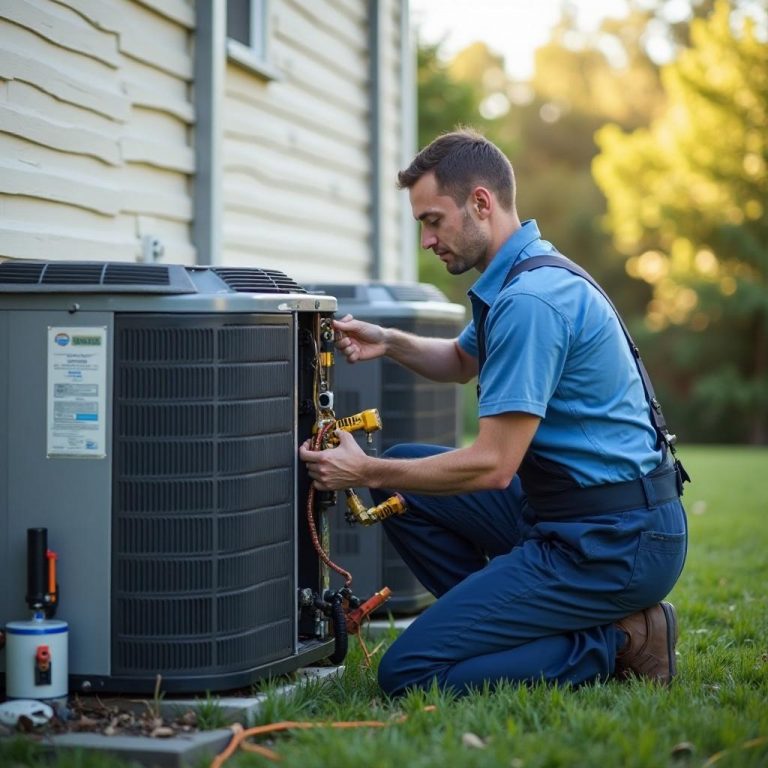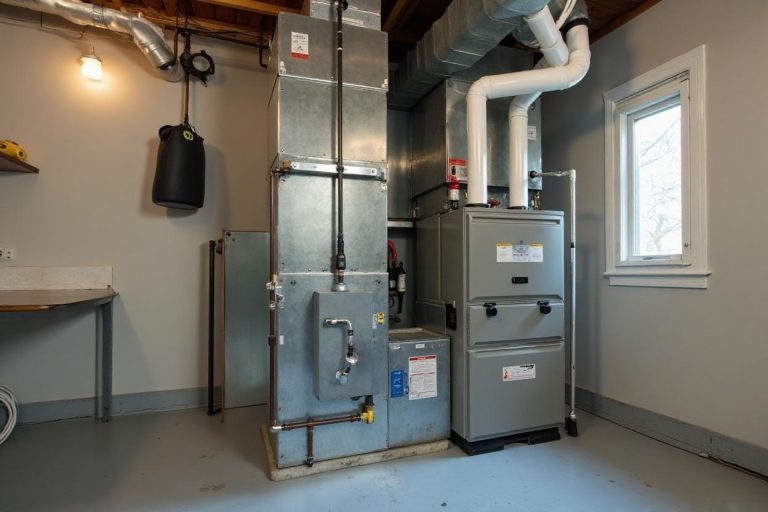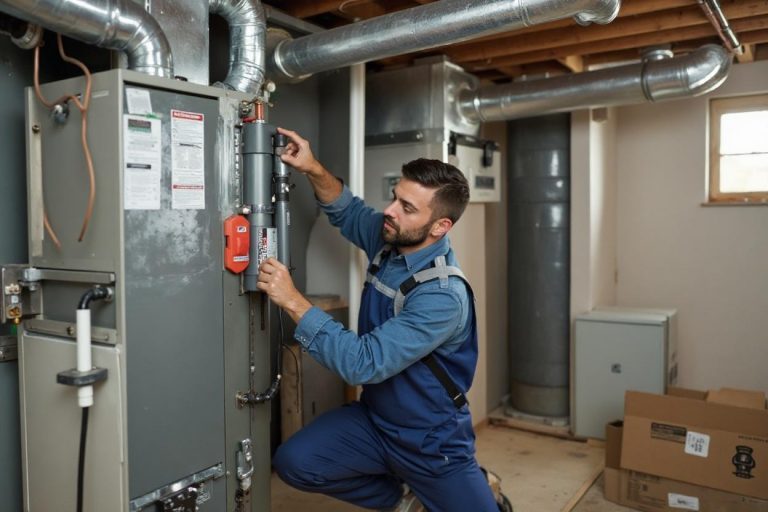How Much Should It Cost To Install A New Furnace In Middlefield, CT?
Homeowners in Middlefield often call us with a simple question that doesn’t have a one-size answer: what should a new furnace installation cost? The honest range for a straightforward replacement in Middlefield, CT runs from about $4,800 to $11,500, with most projects landing between $6,500 and $9,500. That spread reflects real variables in our area: furnace type and efficiency, the home’s size and duct condition, venting requirements, electrical and gas work, and the time of year you schedule.
This article breaks down the costs you can expect in Middlefield and nearby towns, explains what drives the price up or down, and shares how we think through installations in Connecticut homes. You’ll also see where a higher upfront cost pays you back in fuel savings and comfort — and where it doesn’t. If you’re comparing quotes for furnace installation CT, this will help you read those proposals with confidence.
The typical price range in Middlefield, CT
For a standard gas furnace replacement that uses your existing ductwork and venting, our installed prices typically fall in these brackets:
- Budget, standard-efficiency (80% AFUE), single-stage gas furnace: $4,800 to $6,500 installed.
- Mid-range, high-efficiency (95% to 96% AFUE), single or two-stage: $6,500 to $8,800 installed.
- Premium, high-efficiency (96% to 98% AFUE), two-stage or modulating with ECM blower: $8,800 to $11,500 installed.
Oil furnaces trend higher than gas due to equipment cost and accessories like oil filters, valves, and often new venting or liner work. Expect $6,800 to $12,500 depending on efficiency and scope. Propane falls near natural gas pricing, though tank and regulator considerations can add labor.
Electric furnaces are less common in Middlefield because of operating costs. If you’re exploring heat pumps with an electric backup, the numbers look different and often qualify for incentives; that’s a separate conversation we’re happy to have.
These ranges assume a like-for-like replacement in a single-family home, not a new system with full ductwork. If you need major duct modifications, a chimney liner, or a gas line run, costs can climb. On the other hand, a simple swap in a home with perfect access and venting may sit near the low end.

What determines your exact price
Every furnace installation in Middlefield has its own mix of factors. Here’s how we think about them on site.

Furnace efficiency and staging. AFUE (Annual Fuel Utilization Efficiency) tells you how much of your fuel turns into heat. An 80% unit vents through the chimney or a metal flue and costs less. A 95%+ condensing furnace vents in PVC and squeezes more heat out of the exhaust, which lowers your utility bills. Staging matters too. Single-stage runs full blast or off. Two-stage has a low and high fire for quieter, smoother heat. Modulating units fine-tune output and pair with variable-speed blowers for steady comfort. Each step up adds cost. For many Middlefield homes, a 95% two-stage with an ECM blower strikes the best balance between price, comfort, and savings.
Home size and heat loss. We size furnaces based on a load calculation, not square footage guesses. Insulation levels, window area, air leakage, and duct design all matter. A 1,600-square-foot ranch with average insulation might need 60,000 to 80,000 BTU. A 2,800-square-foot colonial may need 80,000 to 100,000 BTU. Larger or higher-BTU units cost more and may require different venting and gas piping.
Venting and combustion air. Older 80% furnaces often use a chimney. If the new unit is also 80%, we may need to install a metal liner or adjust the flue to meet code. High-efficiency furnaces vent through PVC to the exterior. That work can be simple in a basement with an accessible rim joist, or more involved in a finished space, a fieldstone foundation, or a long run that needs support, slope, and condensate management.
Duct condition and airflow. New furnaces run best when the ducts can move the designed airflow. Pinched returns, undersized supply trunks, or leaky joints lead to noise, uneven temperatures, and premature wear. We check static pressure and inspect plenums, takeoffs, and returns. Minor sheet metal modifications add modest cost and pay off in comfort.
Gas, oil, or propane line work. Gas piping sometimes needs upsizing if the new furnace draws more BTUs or if we’re adding a whole-house generator or range. With oil, we evaluate tanks, lines, and filters. With propane, we confirm regulator sizing and tank placement. Adjustments here affect cost and schedule.
Electrical and controls. Bringing the furnace up to current code may involve a new shutoff switch, outlet for condensate pumps, updated thermostat wiring for staging, or a new smart thermostat. Older homes also surprise us with missing or shared circuits, which we correct during the install.
Condensate drainage and freezing risk. High-efficiency furnaces produce condensate that must drain to a floor drain or pump. In Middlefield, we add freeze protection where lines pass through cold areas. Poor drainage is a common failure point on DIY or cut-rate installs.
Permits and inspections. Middlefield and nearby towns require permits and inspections for fuel-burning equipment. We pull those permits, schedule inspections, and build to code. There’s a small fee and some coordination, both included in a professional install price.
Access and labor time. Tight mechanical rooms, steep bulkhead stairs, or furnaces tucked under low joists take more time and care. If we need a second crew member for handling or safety, that affects labor cost.
Seasonal demand. January emergencies are more expensive than an August planned replacement. You’re paying for rapid response, overtime, and the cost of keeping inventory on hand. If your current furnace limps along in fall, schedule before the first hard freeze to save.
The Middlefield context: fuel mix, brands, and building stock
We work in older colonials with brick chimneys, split-levels from the 70s, and newer builds with PVC venting. Many homes in Middlefield still use oil or propane, though natural gas service is available on a number of streets. That variety shapes install scope. For example, moving from oil to gas is doable but adds cost for tank removal, gas line extension, and vent changes. If you stick with oil, we often recommend sealed-combustion oil furnaces to reduce drafts and improve safety.
Brand matters less than the installation. We install and service major brands common in CT. Each has standard, mid, and premium product lines. The big cost differences you see across quotes usually come from the install plan, not the name on the badge. A well-sized mid-range two-stage furnace, installed cleanly with correct vent pitch, combustion setup, and airflow balance, will outperform a premium unit that’s oversized or vented poorly.
Where the money goes: a clear breakdown
Homeowners appreciate a simple view of what you’re paying for. On a typical $7,800 high-efficiency gas furnace installation in Middlefield, a rough allocation might look like this in plain terms: equipment accounts for a big chunk; labor covers removal, setup, venting, gas and electrical work, commissioning; materials include vent pipe, fittings, gas valve, condensate pump, sheet metal; permits and disposal wrap the job legally and neatly; and there’s warranty support and overhead. The exact split changes per job, but this illustrates why the cheapest bid can fall apart — something gets cut, and it’s usually the time needed for testing, adjusting gas pressures, or sealing ducts.
The payback on efficiency in CT winters
Whether a 95%+ furnace pays for itself depends on your fuel cost and how long you’ll stay in the home. Here’s a grounded way to think about it. If your current 80% furnace uses 800 therms of natural gas in a season and you switch to a 96% furnace, your equivalent load drops by roughly 16% on the useful heat. That can save around 115 to 130 therms a year. At $1.50 per therm, that’s about $170 to $195 annually. If the high-efficiency option costs $1,500 more, your simple payback sits near 8 to 9 years. Gas prices, home insulation, and true runtime shift this math, but that’s the ballpark.
Comfort and noise matter too. Two-stage and modulating units run longer at lower fire. You get fewer temperature swings, better air mixing across rooms, and less noise through the ductwork. For homes with cold bedrooms or hot-and-cold zones, staging often solves more than insulation alone. That value is hard to price, but you feel it every day.
With oil, efficiency gains are smaller step-by-step, and fuel prices swing. We focus on safe combustion, sealed air paths, and proper sizing, then compare equipment options that balance long-term maintenance with fuel use.
What’s in a quality furnace installation
Good installs follow a process. We start with a heat loss calculation and a static pressure check, then design the vent path and condensate route. During the install, we set the gas valve, verify inlet and manifold pressure, check temperature rise, balance airflow, and test combustion with a meter. We seal joints, insulate where needed, and label shutoffs. Before we leave, we go over your thermostat settings, filter schedule, and how to spot an issue early.
That list sounds like a lot because it is. It’s why one quote can be $1,000 lower but skip testing and setup that protects your equipment and warranty.
Common add-ons in Middlefield and what they cost
Chimney liner for 80% gas or oil. Masonry chimneys that used to vent both furnace and water heater often need a metal liner for safe draft. Expect $600 to $1,800 depending on height and access.
PVC venting for 95%+. Running new intake and exhaust lines through the rim joist is straightforward. Long or concealed routes raise cost. Budget $350 to $1,200 for materials and labor beyond the base install, depending on complexity.
Condensate pump and drain. If there’s no floor drain, we add a pump and line with proper slope and freeze protection. Expect $250 to $500.
Return air upgrades. Many Connecticut homes are return-starved. Adding a return drop or upsizing a grille reduces noise and improves comfort. This might add $300 to $900.
Smart thermostat and wiring. Staged furnaces need compatible controls. If we must pull new thermostat wire to support two-stage or variable-speed, add $150 to $400. A quality smart thermostat adds $180 to $350.
Gas line modifications. Upsizing or rerouting a section of pipe to meet demand adds materials and time. This can range from $200 to $800 in typical cases.
Oil line and filtration. For oil furnaces, we often replace old copper lines, add a Firomatic valve, and install a high-quality filter. Plan on $250 to $600.
None of these are mandatory in every home, but they are common. Seeing them on a quote is not up-selling; it reflects actual needs we encounter in Middlefield basements.
The replacement timeline and what to expect on install day
Most furnace swaps take one day. We arrive in the morning, protect floors, shut down and safely disconnect the old unit, and remove it. The new furnace gets set, leveled, and connected to duct, gas or oil lines, and electrical. We run venting and condensate lines, then commission the system. You’ll have heat by late afternoon. If the job involves a chimney liner, extensive duct work, or challenging access, it can take two days. We communicate that upfront so you can plan.
Middlefield inspections are typically scheduled within a few days after install. We coordinate with the town so you don’t have to juggle calls. If the inspector wants a tweak, we handle it.
How to compare quotes fairly
It’s easy to line up two numbers and pick the lower one. You’ll make a better decision by reading what each includes. Ask whether the contractor:
- Performed or will perform a Manual J load calculation and measured static pressure rather than using square footage alone.
- Included venting, condensate management, chimney liner work if needed, permits, and inspections.
- Will set gas valve pressures, verify temperature rise, and provide combustion test results.
- Sized the furnace to your ductwork and addressed any return or supply restrictions.
- Offers a written scope, parts and labor warranties, and proof of insurance and licensing.
If two quotes are $1,500 apart but one includes all of the above and the other leaves venting “by others” or “as needed,” the lower price Click for source will grow later or result in a compromised install.
Rebates, incentives, and financing in CT
Connecticut often offers incentives for high-efficiency heating. Programs change, so it’s best to check current options through utilities and Energize CT. In recent years, we’ve seen rebates for qualifying 95%+ gas furnaces and financing options with low rates. Oil equipment incentives are less common, but there are sometimes credits for controls and weatherization that pair well with a furnace upgrade. We process a lot of these applications and can tell you what’s active right now during a free estimate.
If you’re exploring a heat pump with a dual-fuel setup, incentives are often stronger. Some Middlefield homeowners choose a heat pump for most of the season and keep a gas or oil furnace as backup for the coldest nights. That strategy reduces fuel use and can qualify for attractive rebates. It’s worth evaluating if your ductwork supports it.

Signs it’s time to replace versus repair
We replace many furnaces in Middlefield after one of these triggers: repeated heat exchanger cracks on older units, rising gas or oil bills with no other explanation, frequent lockouts and repair visits, a furnace age over 18 to 20 years, or a major part failure where the repair approaches half the cost of a new unit. If your furnace is 15 years old and you’re facing a $1,400 repair, it can be smarter to put that money into a new, efficient unit before winter. On the other hand, a six-year-old furnace with a bad ignitor is a simple repair.
We’ll give you both options when it’s close. Sometimes a $400 airflow fix extends the life of a furnace and saves you from a premature replacement.
Real examples from local jobs
A split-level near Lake Beseck. The home had an aging 80% gas furnace that struggled on the lower level. We installed a 96% two-stage furnace with a variable-speed blower, added a return in the lower family room, and ran new PVC venting through the rim joist. Total cost was about $8,200. The owner reports quieter operation and even temperatures across all three levels, with gas bills down roughly 15% year over year.
A 1960s colonial off Main Street. The oil furnace was 24 years old with a cracked heat exchanger. The homeowner stayed with oil. We replaced the furnace, updated the oil lines and filter, and installed a chimney liner. The job required a second day for masonry access. Installed cost was about $9,900. The new unit runs clean, and soot issues in the boiler room disappeared.
A downsizing couple near Powder Hill. They chose a budget 80% gas furnace after a home energy audit showed limited use and an upcoming move within five years. The job used existing venting with a new flue connector and included a simple single-stage thermostat. Cost was around $5,600. For their timeline, paying extra for high efficiency did not pencil out.
These examples mirror the ranges at the start of this article and show why your situation shapes the right choice.
Practical tips to keep costs in check
You can make smart moves that keep your install on budget without cutting corners. Schedule a pre-season replacement rather than waiting for a no-heat emergency. Tackle basic weatherization like attic air sealing and insulation; a tighter home means a smaller furnace can do the job. Keep ducts accessible where possible; even clearing stored items near the furnace helps us work faster. Choose the efficiency level that fits your fuel costs and how long you’ll stay in the home. If you plan to sell soon, prioritize a safe, reliable unit with clean documentation and a transferrable warranty.
What you should expect after installation
A good furnace install doesn’t end when we pull away. Expect a clean startup sheet with model and serial numbers, thermostat settings, gas pressures, temperature rise, and combustion readings. You should receive warranty registration confirmation, permit documents, and a filter size and change schedule. We schedule a check-in after your first billing cycle, and we offer maintenance plans for annual checks. Annual service in Middlefield typically includes a safety inspection, filter change, combustion analysis, drain cleaning for condensing models, and a look at static pressure and blower performance.
Why homeowners in Middlefield choose us
Direct Home Services focuses on furnace installation CT with a strong local footing. We know which streets have natural gas, which basements flood after big storms, and how Middlefield inspectors like to see PVC terminations. We size systems carefully, present clear scopes, and stand behind our installs. That approach keeps your costs predictable and your heat reliable.
If you want a precise quote for your home, we can visit, run the numbers, and give you two or three clear options with exact prices. Most estimates take 30 to 45 minutes and cost you nothing.
Ready for a quote?
If your furnace is limping or you want to plan a pre-season upgrade, reach out to Direct Home Services. Ask for a free, no-pressure estimate for furnace installation in Middlefield, CT. We’ll measure your home, check your ducts and venting, and lay out your true costs alongside your fuel savings. You’ll get a straight answer and a fair price — and heat you can count on when winter hits.
Direct Home Services provides HVAC installation, replacement, and repair in Middlefield, CT. Our team serves homeowners across Hartford, Tolland, New Haven, and Middlesex counties with reliable heating and cooling solutions. We install and service energy-efficient systems to improve comfort and manage utility costs. We handle furnace repair, air conditioning installation, heat pump service, and seasonal maintenance. If you need local HVAC service you can depend on in Middlefield or surrounding areas, we are ready to help.